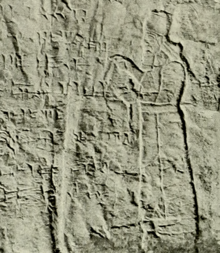Tiglath-Pileser I
| Tiglath-Pileser I | |
|---|---|
| King of Assyria | |
 Rock relief of Tiglath-Pileser | |
| Reign | 1114–1076 BC |
| Predecessor | Ashur-resh-ishi I |
| Successor | Asharid-apal-Ekur |
| Died | 1076 BC |
| Akkadian | 𒆪𒋾𒀀𒂍𒊹𒊏 TUKUL.TI.A.É.ŠÁR.RA Tukultī-apil-Ešarra |
Tiglath-Pileser I (/ˈtɪɡləθ paɪˈliːzər, -ˌlæθ, pɪ-/; from the Hebraic form[1] of Akkadian: 𒆪𒋾𒀀𒂍𒊹𒊏 Tukultī-apil-Ešarra, "my trust is in the son of Ešarra") was a king of Assyria during the Middle Assyrian period (1114–1076 BC). According to Georges Roux, Tiglath-Pileser was "one of the two or three great Assyrian monarchs since the days of Shamshi-Adad I".[2] He was known for his "wide-ranging military campaigns, his enthusiasm for building projects, and his interest in cuneiform tablet collections".[3] Under him, Assyria became the leading power of the Middle East, a position the kingdom largely maintained for the next five hundred years. He expanded Assyrian control into Anatolia and Syria, and to the shores of the Mediterranean.[4] From his surviving inscriptions, he seems to have carefully cultivated a fear of himself in his subjects and in his enemies alike.
Contents
1 Campaigns
2 See also
3 References
4 Bibliography
5 External links
Campaigns
The son of Ashur-resh-ishi I, he ascended to the throne in 1115 BC, and became one of the greatest of Assyrian conquerors.[5]
His first campaign was against the Mushku in 1112 BC, who had occupied certain Assyrian districts in the Upper Euphrates; then he overran Commagene and eastern Cappadocia, and drove the Hittites from the Assyrian province of Subartu, northeast of Malatia.[5]
In a subsequent campaign, the Assyrian forces penetrated into the mountains south of Lake Van and then turned westward to receive the submission of Malatia. In his fifth year, Tiglath-Pileser attacked Comana in Cappadocia, and placed a record of his victories engraved on copper plates in a fortress he built to secure his Cilician conquests.[5]
The Aramaeans of northern Syria were the next targets of the Assyrian king, who made his way as far as the sources of the Tigris. It is said from an Assyrian relief that he campaigned against the Arameans 28 times during his reign from 1115 to 1077 BC. The control of the high road to the Mediterranean was secured by the possession of the Hittite town of Pitru at the junction between the Euphrates and Sajur; thence he proceeded to Gubal (Byblos), Sidon, and finally to Arvad where he embarked onto a ship to sail the Mediterranean, on which he killed a nahiru or "sea-horse" (which A. Leo Oppenheim translates as a narwhal) in the sea. He was passionately fond of the chase and was also a great builder. The general view is that the restoration of the temple of the gods Ashur and Hadad at Assyrian capital of Assur was one of his initiatives. It is also believed he was one of the first Assyrian kings to commission parks and gardens with foreign trees and plants.[5][6][3]
The latter part of his reign seems to have been a period of retrenchment, as Aramaean tribesmen put pressure on his realm. He died in 1076 BC and was succeeded by his son Asharid-apal-Ekur. The later kings Ashur-bel-kala and Shamshi-Adad IV were also his sons.[citation needed]
See also
- Tiglath-Pileser II
- Tiglath-Pileser III
References
^ Spelled as "תִּגְלַת פִּלְאֶסֶר" "Tiglath-Pileser" in the Book of Kings (2Kings 15:29) or as "תִּלְּגַת פִּלְנְאֶסֶר" "Tilgath-Pilneser" in the Book of Chronicles (2Chronicles 28:20).
^ Roux, Georges. Ancient Iraq. Third edition. Penguin Books, 1992 (paperback, .mw-parser-output cite.citation{font-style:inherit}.mw-parser-output q{quotes:"""""""'""'"}.mw-parser-output code.cs1-code{color:inherit;background:inherit;border:inherit;padding:inherit}.mw-parser-output .cs1-lock-free a{background:url("//upload.wikimedia.org/wikipedia/commons/thumb/6/65/Lock-green.svg/9px-Lock-green.svg.png")no-repeat;background-position:right .1em center}.mw-parser-output .cs1-lock-limited a,.mw-parser-output .cs1-lock-registration a{background:url("//upload.wikimedia.org/wikipedia/commons/thumb/d/d6/Lock-gray-alt-2.svg/9px-Lock-gray-alt-2.svg.png")no-repeat;background-position:right .1em center}.mw-parser-output .cs1-lock-subscription a{background:url("//upload.wikimedia.org/wikipedia/commons/thumb/a/aa/Lock-red-alt-2.svg/9px-Lock-red-alt-2.svg.png")no-repeat;background-position:right .1em center}.mw-parser-output .cs1-subscription,.mw-parser-output .cs1-registration{color:#555}.mw-parser-output .cs1-subscription span,.mw-parser-output .cs1-registration span{border-bottom:1px dotted;cursor:help}.mw-parser-output .cs1-hidden-error{display:none;font-size:100%}.mw-parser-output .cs1-visible-error{font-size:100%}.mw-parser-output .cs1-subscription,.mw-parser-output .cs1-registration,.mw-parser-output .cs1-format{font-size:95%}.mw-parser-output .cs1-kern-left,.mw-parser-output .cs1-kern-wl-left{padding-left:0.2em}.mw-parser-output .cs1-kern-right,.mw-parser-output .cs1-kern-wl-right{padding-right:0.2em}
ISBN 0-14-012523-X).
^ ab Leick, p. 171.
^ 'The Collins Encyclopedia of Military History', Dupuy & Dupuy, 1993, p. 9
^ abcd Chisholm 1911, p. 968.
^ Bryce, p. 563.
Bibliography
Bryce, Trevor, The Routledge Handbook of The People and Places of Ancient Western Asia: The Near East from the Early Bronze Age to the fall of the Persians Empire, p. 563
[full citation needed]
Harper, Robert Francis; et al. (1901). Babylonian and Assyrian Literature. New York: D. Appleton and company.CS1 maint: Explicit use of et al. (link)
Leick, Gwendolyn (March 1, 2010). The A to Z of Mesopotamia. Scarecrow Press. p. 171. ISBN 0810875772.
Attribution:
 This article incorporates text from a publication now in the public domain: Chisholm, Hugh, ed. (1911), "Tiglath-Pileser", Encyclopædia Britannica, 26 (11th ed.), Cambridge University Press, p. 968
This article incorporates text from a publication now in the public domain: Chisholm, Hugh, ed. (1911), "Tiglath-Pileser", Encyclopædia Britannica, 26 (11th ed.), Cambridge University Press, p. 968
External links
Inscription of Tiglath-Pileser I. Babylonian and Assyrian Literature. Project Gutemberg.
Inscription of Tiglath-Pileser I, Babylonian and Assyrian Literature, at Internet Archive
Prism of Tiglat Pileser I, at the British Museum.
Assyrian origins: discoveries at Ashur on the Tigris: antiquities in the Vorderasiatisches Museum, Berlin, an exhibition catalog from The Metropolitan Museum of Art Libraries (fully available online as PDF), which contains material on Tiglath-Pileser I
| Preceded by Ashur-resh-ishi I |
King of Assyria 1115–1077 BC |
Succeeded by Asharid-apal-Ekur |

Comments
Post a Comment